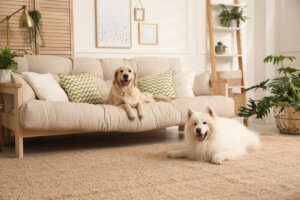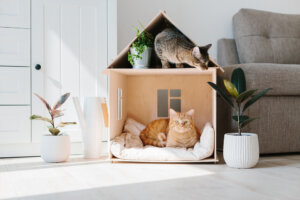Not surprisingly more and more urban Canadians are choosing condominium ownership over single
family home ownership. According to the 2011 Statistics Canada survey, Vancouver has the highest percentage of condominium households at 31.4%, with Calgary coming in second at 20.4% and Toronto sitting at third with 18.7% of residents living in a condo.
Without a doubt, market fluctuations and localized real estate insanity in key markets such as Toronto and Vancouver have only served to make condo ownership more attractive to many segments of the population since 2011. In fact, according to RealNet, an astonishing 57% of new homes that sold in the Toronto area in 2014 were condos.
And since people love their pets, they obviously also want to be able to live with them in their condominiums. In fact, so large is the demand that an informal study by Toronto’s CityPlace development pegged the number of dogs at seven per floor. Smart condo developers are now offering common elements to attract pet owners such as pet spas, doggy daycares and doggy bathrooms, so if you’re a pet lover, look for these developments as you continue your search.
Living with a pet in a condo does however have its challenges. It’s critical to be aware of certain factors that may limit or indeed totally restrict your pet ownership. It’s also important to seek ways to improve your living arrangements with your pet as cleanliness, outdoor access and close neighbours can make life challenging if creative solutions are not thought through.
Let’s start at the beginning. If you’re moving into a new condo and have a pet or are thinking of getting one, make sure you ask the following:
- Are pets allowed?
- If not, best to consider moving on, not moving in. Knowingly moving into a building that has bylaws in place the do not allow pets can cause you a lot of money and heartache in the end – best to avoid
- If so, how many pets are allowed?
- Is there a weight restriction?
- If you have a dog, is their an off-leash park near your new dwelling?
- Is there a green space very close to your condo to take your dog for quick bathroom trips?
Don’t just assume that seeing a tenant with two large dogs in the elevator means that you can have large dogs, or more than one. Older buildings will often have grandfathered rules and bylaw changes, so make sure you inform yourself about your tenant rights before you move in.
Once you’ve made certain that you can move into your new place with your furry family members, next trick is to optimize your lives. Dogs and cats have different challenges when living in condominiums, so let’s break it down.
Dogs
Toronto condo dweller Madelaine Gileadi has two dogs and lives in a high-rise on the lakeshore in Toronto. Here’s some advice she has for dog owners who are considering condominium living.
- Always check your condo rules to see if there are any restrictions on what kind of pets/dogs and how many. Condo rules trump city rules for owners.
- Make sure you go to your condo board meeting! This is when amendments to rules are made – last year, someone tried to pass a rule in Madelaine’s building that all pets had to be carried through the common elements – impossible for the elderly, those with disabilities or large dog owners. It was voted down, but you must participate to have a say.
- Research vets and emergency vets in the area…since it’s a fairly unregulated industry reading reviews helps a lot!
- Small breeds (15 lbs and less), most of whom canget their exercise indoors are the best for condos. Madelaine and her partner have a bichon-shih tzu mix who doesn’t need exercise, in fact he hates it. Playing indoors is enough, and he loves laying out on the balcony. They do take him out for short walks approx 10-15 min three times a day.
- Madelaine also has a slightly larger dog (30 lbs) who does need a lot of exercise…in his case, we made sure to buy a condo a short distance from an off leash dog park. Off lease dog parks are great for when you get home from work exhausted but your dog has sooo much energy. They can run around and you can take a seat and relax.
- In terms of walking your dog, Madelaine and her partner realized after they bought that most of the green spaces around their condo were off limits to dogs which makes it tricky for the late night, last walk before bed. You should also ask other dog owners in the building, before buying, where the best spots are to walk your dog. Madelaine found out through word of mouth too late that there are coyotes who attacked another dog, in the only walkable area adjacent to the building.
- Baby gates are your friends for keeping your barking and anxious dogs away from the front door.
- Because a condo is traditionally a smaller space, setting a designated space for your pet that gives them the most visibility will lessen any anxiety.
- If you can afford to, replace your balcony door with one that has a doggy door (our dogs love going in and out at their leisure). Cats would love this too and in a condo you don’t have to worry about other, unwanted creatures coming in such as raccoons.
Cats
Cats are the ideal condo pet. They don’t need to go outside for exercise, are absolutely fastidious and like nothing more than to lounge around and sleep in the sun. If you’re a traveller, it’s simple and inexpensive for someone to come into your home to clean the litter and ensure your cat has food and water while you are gone. Also, cats do not bother neighbours as they do not go outside, make no noise and never visit common areas.
No matter how much you love your cats however, dealing with smelly cat pee and poo on a daily basis is a downright well…bummer, particularly in a condominium. Managing odour in a small space, and the litter underfoot is a constant battle. The best way to deal with the smell is to scoop the cat’s litter every day and keep the area clean. As for the litter creep and the unpleasant visual aspect associated with seeing your cats’ waste in common living areas, there are other strategies to deal with this.
In a condo, every square foot counts, so it’s important to think deeply about where to put the litter box. Most people don’t want the litter area to be in visual sight (for hygiene reasons as well, especially if you have kids or other pets), so areas such as living rooms, kitchens and bedrooms are off-limits. This restricts your choices to bathrooms, and other spaces that you can use inventively.
Many people have built custom solutions that are pretty cool. Alternatively, you can look into purchasing cat litter box furniture. Either solution will hide your cats’ litter in attractive furniture, as well as minimize the spread of litter throughout your condo.
Please leave comments with your tips and tricks about how you deal with your pets while enjoying condo living. Good luck with your choice of condominium!


